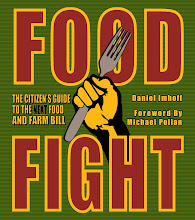In a rush to pass some sort—any sort—of food safety bill, Congress has penned a piece of legislation that might actually harm the very farmers that hold the answers to our food safety challenges.
Before leaving on its August recess, Congress passed House Resolution 2749 (HR 2749). This bill gives the Food and Drug Administration (FDA) sweeping powers to regulate American food producers, but in doing so, it does little to distinguish between huge multinational corporations and small family farms producing food to sell in their local communities. According to Opencongress.org, HR 2749 grants the FDA “the authority to regulate how crops are raised and harvested, to quarantine a geographic area, to make warrantless searches of business records, and to establish a national food tracing system.” To fund this effort, the bill proposes raising a $500 registration fee on any facility “holding, processing, or manufacturing” food.
As we wait for the Senate to return from recess and take up this bill, it is worth considering its effects on small-scale farmers and local food producers. Across America, communities are working to create strong, viable regional food systems. From Alabama to Washington, locals are supporting small sustainable farms, establishing farmers markets, creating local food co-ops. They do this not just because they appreciate the sweet perfection of just-picked tomatoes and melons—but also because they know that by strengthening local farms and food processors they are more likely to have a reliable supply of safe, healthy foods for their children and their grandchildren. Who needs a bureaucratic food registry system when you can drive across town and visit the farmers who grew your lettuce, made your cheese, or canned your pickles?
In its current form HR 2749 could have a disabling effect on many small scale farmers. The $500 registration fee required to be paid by any farm that processes food is unreasonable to ask of small farms. During a committee hearing, one of the bill’s sponsors Henry Waxman (D-California) pointed to large corporate food producers in his defense of the fee structure: “In the recent peanut (salmonella) outbreak, Kellogg’s alone lost $70 million. Faced with such a dire situation, I think it is reasonable to ask the food industry to chip in.” This is all well and good, but the problem arises when Waxman and his colleagues fail to differentiate between Kellog’s—which reported $12.8 billion sales in 2008—and little Grandma’s Jams and Jellies that made, let’s say, $12,800 in 2008.
Several farm organizations and US Representatives have expressed their concern about the fee structure:
Representative Sam Farr (D-California), during a committee hearing, said this:
"I have deep concerns ... about the fee structure in the measure, which would charge a farm family making jams or syrup or cheese the same fee as a processing plant owned by a multinational corporation employing hundreds or thousands or workers. This strikes me as not only unfair but contrary to federal farm policy that has encouraged small and mid-sized family farms to get into small scale value-added enterprises to survive economically. I am seeking an assurance ... that a more progressive fee structure will be found that does not inhibit our farm families from taking advantage of new markets."
A letter presented to Henry Waxman by seven concerned members of Congress stated:
"More and more, farms are adding value to their products on the farm as a way to survive economically in an inherently volatile sector […] If small or diversified farmers knew that they had to pay an annual fee of $500 to process their product on their farm, many would opt not to explore such market innovations."
The National Sustainable Agriculture Coalition and the National Organic Coalition, in a letter to bill sponsor Representative Dingell (D-Michigan), wrote this:
"While H.R. 2749 bill exempts facilities that sell over 50.1% of their processed products directly to the consumer, it still imposes a fee on those who primarily sell wholesale. We represent a large number of farmers who sell their value-added products to the wholesale market as well as a large number who sell direct to consumer, and in fact, most farmers increasingly do some of each. […] H.R. 2749 requires facilities of all size, regardless of whether their annual revenue stream is $1,000 or $1 million or $100 million, to pay the same fee. […] This is a fundamental issue of equity. The tax in the bill as written and approved by the House violates the basic principle of ability to pay which is the bedrock of our system."
While the proposed law includes certain exemptions for farmers that primarily sell directly to consumers, restaurants, and grocery stores, farms that sell primarily to other local venues such as caterers and school or hospital cafeterias would not qualify. The NSAC and NOC worry that “there is increased demand for locally-produced agricultural products in school cafeterias, but as it stands, the language in HR 2749 would not exempt farmers selling direct to institutional settings which could dampen farmer interest in these important new markets that stand to provide healthy, fresh food to our nation’s children.”
Let’s stop and think for a minute about where the most prevalent food safety problems come from. Salmonella and E. coli are the bacteria that seem to most often cause outbreaks in the US—and both originate exclusively from animals. E. coli lives in the gut of ruminants; The main culprit for spreading this disease is cattle. The corn-fed cattle in industrial feedlots carry by far the most E. coli bacteria. (A 2009 study by the USDA found that “When cattle were abruptly switched from a high grain diet to an all hay diet, total E. coli populations declined 1,000-fold within 5 days.”)
Miraculously, however, it seems that all of the large-scale industrial animal operations would be exempt from the regulations proposed under this bill (see "USDA Exemptions" section of bill on govtrack.us)....when in fact it is these industries where most of our food-borne illnesses begin. It is the massive industrial farms that need targeting—not a misguided effort to control the demonized "leafy greens." Let's focus our attention where it is truly productive: the mega meat feedlots and slaughterhouses. Instead of HR 2749, Congress would be better suited to pass something closer to Kevin's law—a.k.a. the "Meat and Poultry Pathogen Reduction and Enforcement Act." This bill was introduced by Anna Eshoo (D-California) along with 36 Republican and Democratic co-sponsors in 2005, but never became law. It would have focused the fight for food safety squarely on the large meat producers, where it belongs.
The idea of promoting food safety is a noble one: To protect consumers from food-borne illness that could suddenly and silently harm them or their families. The solution proposed by HR 2749, however, fails to focus narrowly on the most likely sources of illness: meats and other foods processed in massive facilities, and food imported from abroad. Instead, it risks slowing down the regional food movements that actually promise solutions to our food safety problems. Rather than holding back small-scale farmers, we need to be urging them forward. They represent the future of American food: a network of regional food systems where food is traceable and farmers are accountable because they are right down the road.
*Visit the Community Alliance with Family Farmers (CAFF) website for links to various Congressional hearings, statements by farm organizations, and information about other shortcomings of HR 2749.
*Visit Wild Farm Alliance’s compilation of articles related to the food safety bill and other related topics issues.
*Read Carolyn Lochhead’s San Francisco Chronicle article on resistance to the bill.









